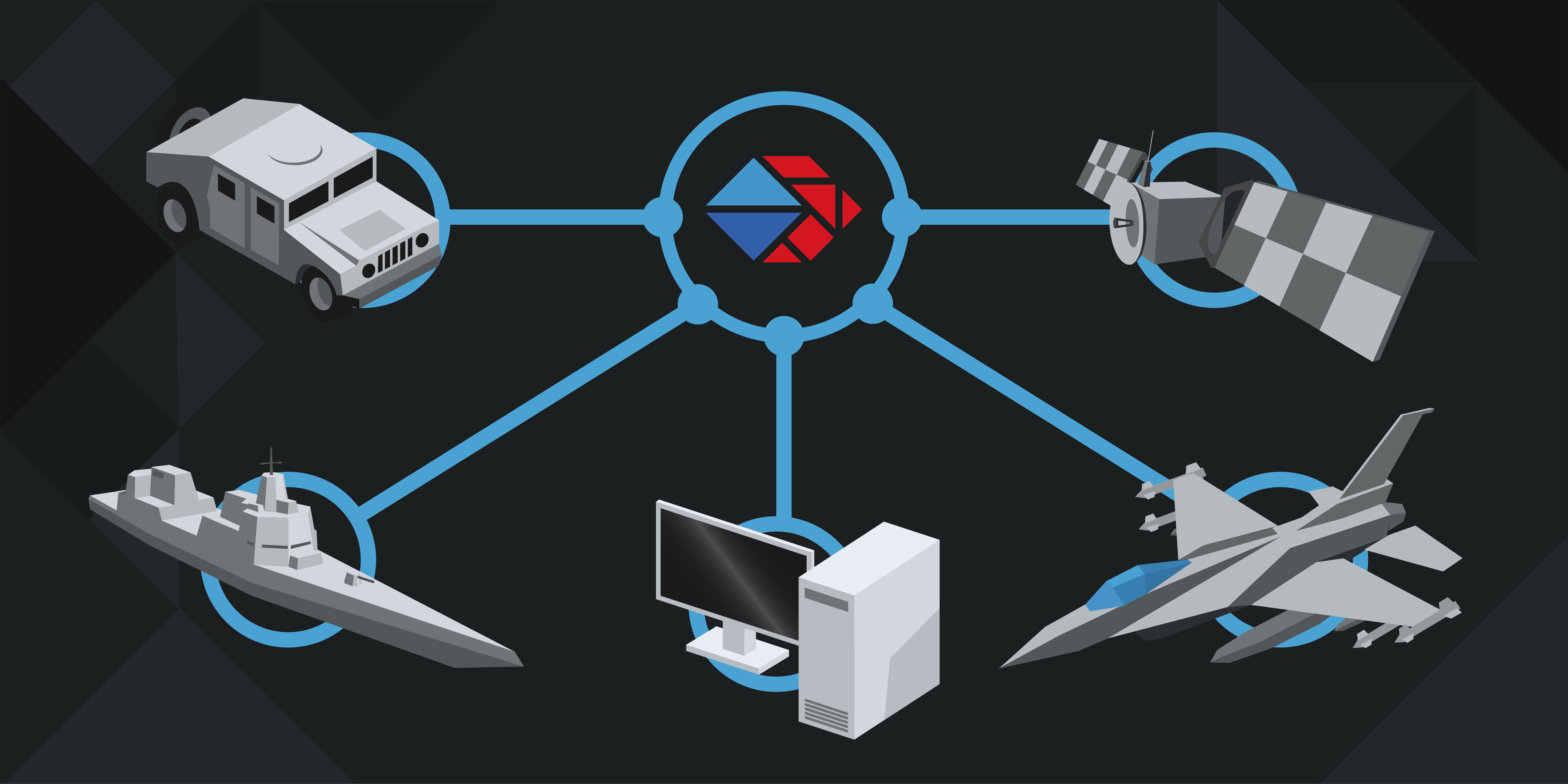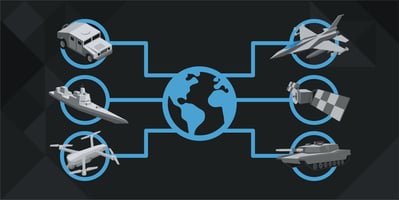This article is part of Overcoming JADC2 Software Challenges, a series of reflections on software...
Achieving Rapid Interoperability
This article is part of Overcoming JADC2 Software Challenges, a series of reflections on software challenges faced by the Joint All-Domain Command and Control initiative written by Tangram Flex’s CTO Matt Naveau.

In a prior article, I discussed the value of adopting a Modular Open Systems Approach (MOSA) and how critical this is to the success of the US Department of Defense’s (DoD) Joint All-Domain Command and Control (JADC2) initiative. MOSA holds the potential to accelerate integration and improve the customer/supplier relationship, which together will get capabilities delivered to the warfighter faster. With any complex system relying on multiple MOSA standards, as “real world” systems usually need to do, integration of systems creates interoperability challenges. For JADC2, this interoperability challenge must not only be overcome but must be achieved at the speed of mission relevance. To keep up with a rapidly changing battlefield, systems must be connected for today’s mission and then quickly reconfigured for tomorrow’s.
Since JADC2 is “all-domain”, this means a lot of interoperability is needed. New and old aircraft platforms must be able to connect together, existing and new surface and subsurface vessels must communicate, and ground vehicles must interoperate to stay relevant and ahead of an adversary in an ever-evolving battlefield. To be “joint” means that all of the services must work together: Air Force, Army, Navy, Marine Corps, and Space Force systems must all interoperate for joint missions. The US also needs our coalition partners, which means that their systems must be made interoperable with their US counterparts. As recent experiences in Ukraine highlight, commercial systems are also relevant in the modern battlefield, and secure interoperability between them and military systems is another consideration. This type of “mega interoperability” is a core idea of JADC2, and it is critical to achieve this interoperability at mission-relevant speed to stay ahead of adversaries. To realize the JADC2 vision, the United States must be able to field and control the best of the best for today’s mission, no matter how different it is from yesterday’s mission. Everything needed for the mission must be ready to interoperate at the exactly the right time.
In theory, interoperability challenges are straightforward to address – connect the things together with any adapters needed to make them understand each other. Yet in practice, this is notoriously difficult. There are a tremendous number of details in hardware and software that must match up perfectly to achieve even basic interoperability. Data formats and the protocols that move the data must align with a shared understanding. Without this shared understanding, computer systems cannot communicate any better than a person who speaks only American English can communicate with a room full of people fluent only in German. Humans need to agree to speak the same language, or they need to use a translator to convert between languages. Computer systems are the same way. Either they need to agree on a common communication standard, or they need to use an adapter to translate between standards.
Interoperability challenges are not unique to JADC2. Everywhere that there are computer systems, there are interoperability challenges. I own a PC, iPad, and Android cell phone. All three devices have adopted the common MOSA standard Universal Serial Bus (USB) and are “standards compliant.” However, out of the box they are not directly interoperable. Each device uses a different type of USB connector. To connect my iPad to my PC, I need a purpose-built adapter cable. To connect my cell phone to my PC, I need a different purpose-built adapter cable. Both of these cables work, but I can’t use one for the other.  Additionally, my older Android cell phone needed a different adapter to connect to my PC than my current one does, and my wife’s older iPhone used yet another USB adapter than my iPad. When we upgraded our devices, we needed new adapters. In our house, that makes for a lot of adapter cables sitting around. The defense industry would be wise to learn from the consumer electronics industry on this one. MOSA is powerful and can create a single interoperability standard (like USB), but even with a single standard adoption can be challenging and require adapters (like all of those different USB cables).
Additionally, my older Android cell phone needed a different adapter to connect to my PC than my current one does, and my wife’s older iPhone used yet another USB adapter than my iPad. When we upgraded our devices, we needed new adapters. In our house, that makes for a lot of adapter cables sitting around. The defense industry would be wise to learn from the consumer electronics industry on this one. MOSA is powerful and can create a single interoperability standard (like USB), but even with a single standard adoption can be challenging and require adapters (like all of those different USB cables).
Historically, the defense industry has approached interoperability challenges in two ways. One method is to create purpose-built adapters to connect systems together. Purpose-built adapters are usually straightforward to develop, and they can be hand-crafted for the particular systems of interest. This enables purpose-built adapters to fit into existing mission computers, communication systems, and networks to simplify their integration. Purpose-built adapters can also be architected to give mission-level redundancy and allow mission planners to maintain interoperability even under a host of degraded capability situations. The biggest downside to purpose-built adapters is that they are difficult to reuse.  New adapters are almost always needed for new integrations, which means that new development must always be taking place. In consumer electronics, this is what Apple, Google, and others have done by providing specialty cables to connect their new devices to other systems. With consumer requirements in mind, they determine that they can increase the speed of delivering new devices by making changes to their systems, such as switching to different types of connectors. An intentional part of this decision in their speed-to-market push is to break backwards compatibility, which means that new adapters are required for new devices. Consumers have access to the newest technology every few months but are forced to purchase new adapters with new devices.
New adapters are almost always needed for new integrations, which means that new development must always be taking place. In consumer electronics, this is what Apple, Google, and others have done by providing specialty cables to connect their new devices to other systems. With consumer requirements in mind, they determine that they can increase the speed of delivering new devices by making changes to their systems, such as switching to different types of connectors. An intentional part of this decision in their speed-to-market push is to break backwards compatibility, which means that new adapters are required for new devices. Consumers have access to the newest technology every few months but are forced to purchase new adapters with new devices.
The other method the defense industry has taken to address interoperability is to build a multi-purpose interoperability gateway to connect things together. When done well, these gateway solutions can be flexible to accommodate a variety of systems. However, multi-purpose adapters, which address a broad range of interoperability challenges, are far more complex to implement than specialized ones. Multi-purpose gateways also create architectural challenges in deployment, as they can be a single point of failure in a connected network. If a mission designer is relying on an airborne multi-purpose gateway, that gateway must stay in the air in the communication range of the systems that depend on it, or the interoperability connection is gone. In consumer electronics, multi-purpose gateways are single boxes with lots of cables dangling out of it that allow many devices with many different connectors. Such gateway devices are typically created by third-party adapter manufacturers who specialize in interoperability, and they tend to be more expensive to purchase than a purpose-built adapter cable. Multi-purpose gateways can also suffer from obsolescence challenges; as device manufacturers change their connectors, gateway makers must update their gateways quickly to stay relevant.
"An interoperability tool combines the ready-for-anything advantage of a multi-purpose gateway with the customized-for-my-mission advantage of a purpose-built adapter."
In defense, a new approach to addressing interoperability challenges is emerging: using tools to generate purpose-built adapters. An interoperability tool combines the ready-for-anything advantage of a multi-purpose gateway with the customized-for-my-mission advantage of a purpose-built adapter. This kind of tool synthesizes the knowledge of available interfaces and connections to generate exactly the adapter needed for the mission, delivering the capability faster than a hand-crafted adapter and more tailored for specific mission needs than a multi-purpose gateway. An interoperability tool can produce a capable adapter for today’s mission and then quickly generate an entirely different adapter for tomorrow’s mission, without needing a major development effort. A good interoperability tool is a push-button mechanism for connecting things together at the software and communication levels.
The DARPA System of Systems Integration Technology and Experimentation (SoSITE) program has led the way in demonstrating that interoperability tools can make an impact. Through a series of experiments and large-scale demonstrations with the System-of-systems Technology Integration Tool Chain for Heterogeneous Electronic Systems (STITCHES) tools, the program showed that distributed capabilities across interoperable platforms is possible and that interoperability tools like STITCHES could make that required interoperability a reality. While STITCHES showed that it is possible, real world use cases have continued to underline the reality that interoperability is complex. Yet a tool-based approach continues to be promising in reducing adapter development time, far beyond that of the efforts of a single individual or team.
"Our team is driven to deliver critical interoperability solutions to our warfighters at mission-relevant speed."
At Tangram Flex, we believe that using tools to rapidly create custom adapters for interoperability is necessary to achieve the vision of JADC2. That is why we’ve built our own interoperability adapter generation tools. Included in our Tangram Pro Developer toolkit, our tools strive to meet the challenges of “faster” and “reusable” better than other solutions available today. We’ve pulled together some of the best minds in the industry to help us create a tool that is user-friendly, is flexible enough to meet known and emerging requirements, integrates well into a modern engineering environment, and is built to scale to large interoperability challenges like JADC2. Alongside that tool, we’ve assembled a world-class engineering team with expertise in interoperability, poised to solve the most difficult integration challenges ahead. We believe that the best way to overcome interoperability challenges at the speed of mission relevance is to utilize tools that can quickly produce custom adapters for today’s interoperability and to be ready to do the same again tomorrow. Our team is driven to deliver critical interoperability solutions to our warfighters at mission-relevant speed.
We have used Tangram Pro to achieve rapid interoperability in a variety of DoD use cases including
- Connecting control station software (also called “human-machine interface” or HMI) built to one MOSA standard to an autonomous aircraft built to another
- Interfacing military autonomy software with non-military open source control software
- Bridging simulation systems that were never made to work together
- “Joint” connectivity between OMS (Air Force-relevant) and FACE (Army-relevant)
- Enabling a mix of systems built to different versions of the same MOSA standard to share information
Through this work, we’ve demonstrated how Tangram Pro can address JADC2-relevant formats like OMS, FACE, and NATO STANAGs, and we’ve shown that our tools are quick for new users to adopt while being flexible enough to meet a variety of use cases. Our team is driven by a desire to give our warfighters the connected capabilities they need to succeed, and we continue to push the edge of technology to make this happen for them.
For the JADC2 mission to succeed, the challenge of quickly connecting platforms and systems native to a variety of MOSA standards must be overcome. While some situations may still call for hand-developed adapters and multi-purpose gateways, tools that can generate interoperability adapters can significantly accelerate the speed of delivery to our warfighters far beyond what human engineers can do alone. With all of us pulling together as a team using the best technology available, we can make the JADC2 vision of rapid interoperability a reality for our warfighters.




